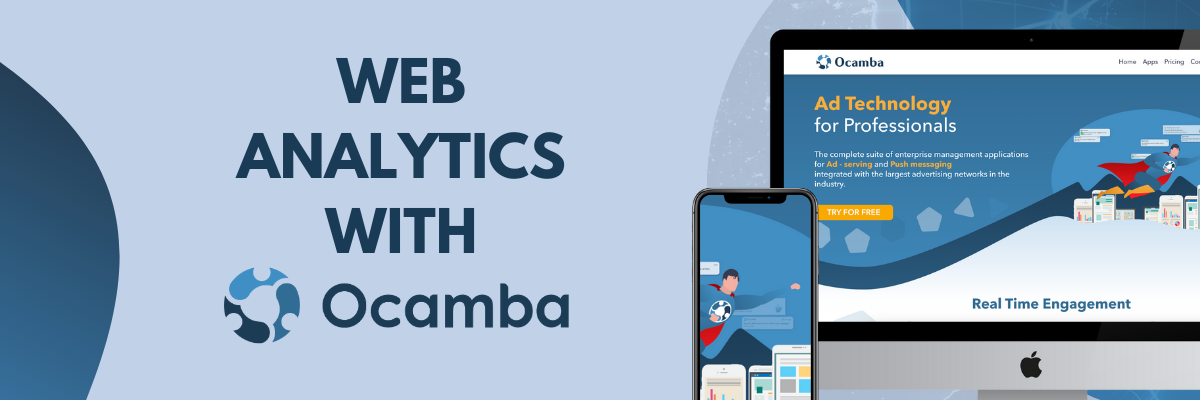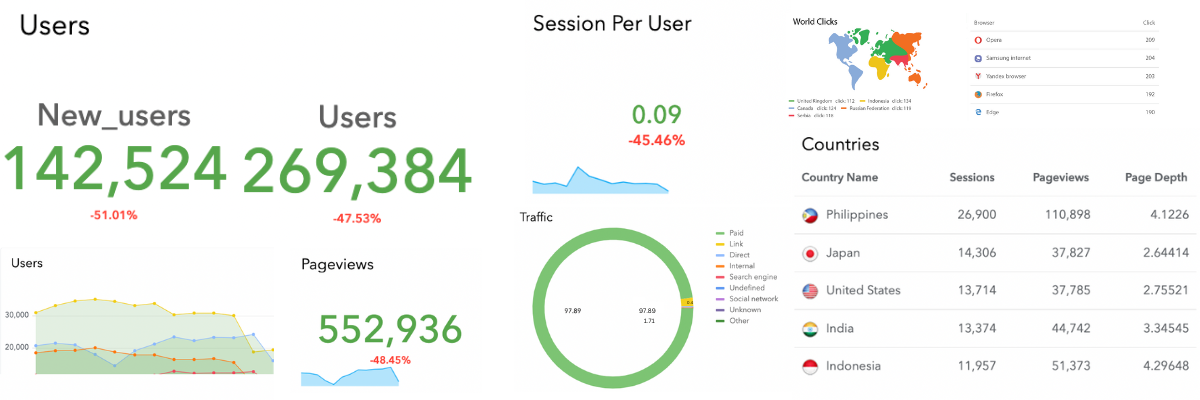Web Traffic Analytics and Real-Time Engagement in One Platform

Web Traffic Analytics and Real-Time Engagement in One Platform
The customer experience (CX) is one of the most important factors in the business world. Running an online business without paying attention to web traffic analytics would be like having a retail store and never opening the register to count your money or never, ever doing your inventory.
First, you wouldn’t be aware of how well your business is doing, other than relying on your subjective impression. Second, it would give you no insight into your best-performing products and services.
If we were to use our previous example and compare an online business to a brick-and-mortar store, it would become clear that engagement is more complex. While face-to-face engagement is quite simple, in a digital world, engagement can mean several different things for your business strategy. Even the same message can make a different impression, depending on the form in which it was sent.
Usually, you would have to use two platforms to handle engagement and analytics. Fortunately, Ocamba provides both of these services in a single platform. Here’s why Ocamba’s Hood App is an excellent solution for this task and where it stands apart from some of its closest competitors.
In this article, we will give you some real-life examples of how a single web traffic analytics platform can help you revolutionize your marketing strategy in its entirety. From segmenting your audience to profiling and engaging them, here’s what you need to know.
Superior Insight through Web Traffic Analytics
The complexity of your web analytics task usually depends on the tools that you have available. Here are a couple of examples to clarify.

A simple, customizable dashboard
Still, how difficult would it be for one without any experience to get into web analytics? The truth is that it’s pretty easy, seeing as how the dashboard mostly offers a graphical representation of what’s going on. Pie charts, graphs, and even color-coding can help you understand Ocamba Analytics more clearly.
One of the first things you’ll notice about Ocamba analytics is the customizability of the dashboard. It means that you can have separate views on the position of different analytical widgets. You can customize and make a choice of what goes where. It also means that you don’t have to learn how to issue complex orders to rearrange the dashboard, seeing as how it all works on a drag-and-drop principle. To clarify, the default setup of the dashboard already provides you with all the data you need. You still have the freedom to change widgets to make their layout more to your liking.
The dashboard is designed to help both website and mobile app owners understand their audience better and spend less time staring at tables, trying to discern the meaning of it all.
Easier audience segmentation
One of the most important reasons to track website traffic is your ability to understand and segment your audience. This helps you adjust the strategy, manage campaigns more effectively, and increase the impact of each campaign on your target audience.
It’s also worth pointing out that even the most powerful real-time analytics tools often depend on direct user input. In other words, every platform has some limitations, and it’s up to you to learn how to overcome them. While analytical tools are getting more sophisticated, it’s still not a crystal ball.
When a user enters your domain, you can use visitor website tracking to see where they came from, how long they stayed on your website, how many previous visits they’ve made, etc. In other words, every piece of data that Ocamba provides can be used in analytics. On the other hand, some data (like their actual age) cannot be obtained this way. So, in order to get it, you would have to get this data via a poll or a questionnaire.
The thing worth pointing out is that the targeting is done through user-entered data. While registering, your users will probably be asked to enter their date of birth, sex, etc. It’s this data that’s later used in the audience segmentation, labeling and targeting process.
Labeling users
Let’s imagine a scenario where a visitor comes to your website and your analytical tools identify it as a qualified lead (perfect potential customer). Wouldn’t they be someone worth keeping an eye on? Of course! By labeling a visitor, you’ll be able to tell them apart from a mile away.
In Hood App, you can label your users to track them more easily in the future. This allows you to identify qualified leads (also referred to as low-hanging fruits) for your most profitable audience segment.
Post-Analysis Engagement
Imagine using one platform to analyze your audience and another to reach out to them. While this wouldn’t be out of the ordinary, there is a way to simplify the process. What if you could do it all via a single control panel?
One thing that sets Ocamba apart from its competitors is the fact that it gives you analytics and engagement in a single solution. You can identify your audience, analyze them, and develop an active messaging strategy through push notifications.
Why push notifications?
Push notifications have numerous advantages over traditional message marketing. First, they’re less invasive (no one is ever going to wonder where you’ve got their number, unlike with Viber messages). Second, you can tailor the message to contain a more effective CTA.
At this point, some people are a bit intimidated by the technical aspect of creating push notifications but creating and customizing them in Ocamba is as simple as it gets. To start, all you need to know is what to copy and where to paste it.
You can also customize who and when gets these notifications. One of the things that the analytics will pick up is how people interact with these notifications. You will see exactly if:
- Their device is woken up.
- The message is delivered.
- The message is received.
In other words, you also see if they’re giving the desired effect in real time.
Further customer analytics through push notifications
Besides this, you will also get an insight into the number of clicks on the notifications and conversions. Keep in mind that some notifications might not result in success.
- Some messages will fail to be delivered.
- Sometimes people will even unsubscribe from your services to avoid receiving further notifications.
Remember that even these failed engagements are a valuable metric. First of all, they don’t have to be your direct failure. Chances are that something went wrong with the server, or anywhere else along the communication line.
If it’s the content of the message (or the feeling of being spammed) that causes people to unsubscribe, you can use this failure as a learning experience. It’s like when you fail a job interview. Understanding why you’ve failed gives you something to improve and it reduces the chance that you’ll make the same mistake in the future.
In this particular situation, it will help you develop a better awareness of when you’ve gone too far (sent too many notifications in a short time span). This is important because mass senders often have a problem with finding the right number of push notifications to keep the balance between staying in touch and not driving away their subscribers.
More considerate notifications
For our next feature, imagine yourself passively keeping track of a boxing match. While, in real-time, you may be interested in the result of every single round (and want to see a notification), after the match is over, these pieces of info will be completely irrelevant.
If one fighter scores a knockout in the 6th round, the notification about the first round being even is no longer relevant. In some scenarios, it’s only the latest piece of information that matters (like when tracking the value of a stock or the exchange rate of a currency). In this way, updates make previous information obsolete (even completely irrelevant).
For this particular scenario, you have the Type Tag notification option, which allows you to set conditions under which a new notification will push an old (unread) one aside. This feature helps you appear less invasive, which automatically makes you more appealing.
Simply put, Type Tag notification settings allow you to avoid swarming your audience with unnecessary information (or even too much information) and only provide them with up-to-date/most relevant information.
A Chance for Additional Monetization
As an online business, one of the key conditions for survival is to diversify sources of revenue. Now is the time for you to ask yourself – Is the use of all these notifications optimized for profit?
What happens if you have more notification recipients and more notifications sent than your business can use? Can this be turned into profit as well?
You can virtually sell your notifications to the highest bidder through Ocamba’s AdExchange feature (or rent out, to be more precise). Through a synergy of AdExchange and push notifications, you can use real-time bidding to make some extra money.
Here’s how this works, you have a user subscribed to your notifications. Instead of your message, you can use these notifications to deliver an ad by the highest bidder. Via the repeat request on click feature, you can maximize your profits by sending the most vigilant of your readers as many notifications as they can handle.
To explain, this is really efficient (and so appealing to advertisers) because a user device doesn’t have to actively use the application or browse the site to receive a notification. It gives both the notification (and the ad that’s bidding for it) a far greater reach than it would otherwise have.

Wrap Up
To send a meaningful message, you must know who you’re communicating with and pay attention to the message form, at the same time.
Understanding your target audience is key to success in any field. Online, this is heavily dependent on your web traffic analytics. Still, analyzing (or even understanding) on its own, is not enough. You must also take advantage of this knowledge by reaching out with personalized notifications.
One more thing we have to mention here, while Ocamba is beginner-friendly and its UI is quite robust (as it is), the platform offers even more to its advanced users. Via API access, these advanced users can explore the full extent of Ocamba’s customizability.
A tool like Ocamba can allow you to perform both of these tasks from a single control panel. Alongside other features (like those that allow additional notification monetization), this platform has all you need to take full advantage of your current digital exposure (and further expand it in the future).















 www.ocamba.com
www.ocamba.com